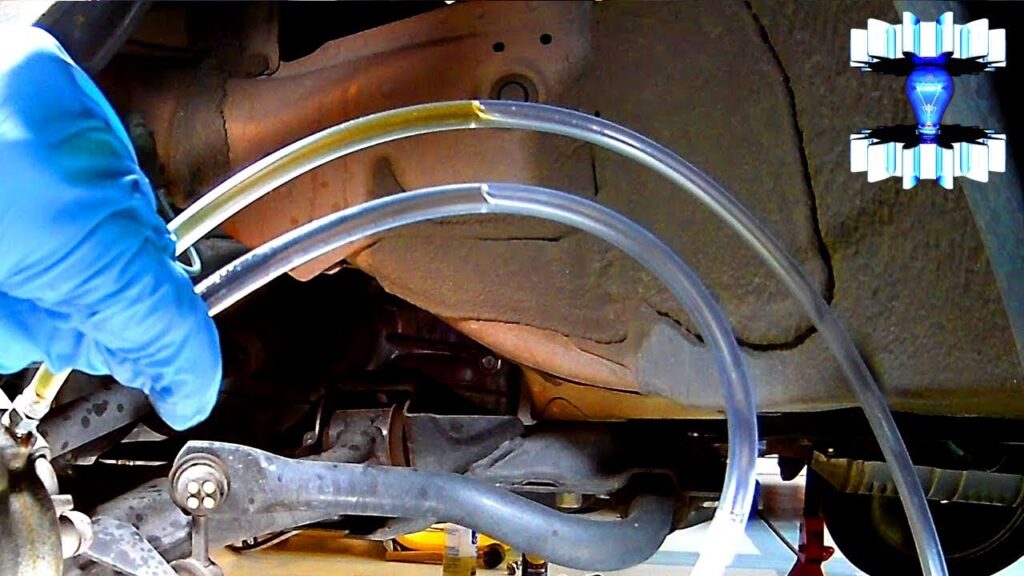Brake fluid is a type of hydraulic fluid used in hydraulic brake and hydraulic clutch applications in vehicles. It is used to transfer force into pressure, and to amplify braking force. Simply stated, when you apply your foot to the brake pedal, brake fluid transfers this force into pressure to the front and rear brakes and stops the vehicle. It works because liquids are incompressible.
Brake fluids must have certain characteristics and meet certain quality standards for the braking system to work properly. Brake fluid is subjected to very high temperatures, especially in the wheel cylinders of drum brakes and disk brake calipers. It must have a high boiling point to avoid vaporizing within the lines. Vaporization is a problem because vapor is highly compressible relative to liquid, and therefore negates the hydraulic transfer of braking force which will result in the brakes failing to stop the vehicle.
Most brake fluids used today are glycol-ether based. Glycol-ether (DOT 3, 4, and 5.1) brake fluids are hygroscopic, which means they absorb moisture from the atmosphere. Glycol based brake fluid starts to absorb moisture from the moment it is put in the hydraulic brake system or exposed to the air. The fluid attracts moisture through microscopic pores in rubber hoses, past seals, and exposure to the air. The problem is obviously worse in wet climates where humidity is high.
For reliable and consistent brake system operation, brake fluid must maintain a constant viscosity under a wide range of temperatures, including extreme hot and cold. Viscosity can be thought of as the thickness of fluid, or the resistance to flow. This is especially important in vehicles equipped with an anti-lock braking system (ABS), traction control, and stability control (ESP). The hydraulic units in these systems have numerous small holes and channels, some of which are smaller than the diameter of a human hair. Brake fluid with the wrong viscosity can have fatal consequences for the function of modern brake systems.
Brake fluid is designed to protect the metals used inside components such as calipers, wheel cylinders, master cylinders, and ABS control valves. The fluid must also protect against corrosion as moisture enters the system. Additives (corrosion inhibitors) are added to the base brake fluid to help accomplish this.
Brake fluids must maintain a low level of compressibility, even with varying temperatures, to accommodate different environmental conditions. This is important to ensure consistent brake pedal feel. Whether you have been driving and using the brakes all day, or you have just started your vehicle and used the brakes for the first time, the pedal should feel the same. As compressibility increases, more brake pedal travel is necessary for the same amount of brake caliper piston and wheel cylinder force, and the brake pedal feels different.
Brake fluid should be tested for water and copper content. Electronic testers and test strips are commercially available to measure both moisture and copper content. The corrosion inhibitors in brake fluid degrade over time. Degraded inhibitors in conjunction with the presence of excessive water cause corrosion in the braking system. After only a year of service, the brake fluid in the average vehicle may contain as much as two percent water. After 18 months, the level of contamination can be as high as three percent. After several years of service, it is not unusual to find brake fluid that contains as much as seven to eight percent water.
Excessive water content will decrease the boiling point of brake fluid and increase the risk of vapor lock. The compression of a vapor lock when applying the brake pedal can lead to total hydraulic brake system failure. Water also promotes corrosion of important metal brake components.
Most automotive professionals agree that glycol-based brake fluid (DOT 3, DOT 4, DOT 5.1) should be flushed, or replaced, every one to two years, or when the brake fluid fails a test for water and copper content. The first metal to corrode is copper. You can determine when it is time to replace brake fluid when copper ions hit 200ppm. When water content exceeds three and a half percent, it is advisable to flush the brake fluid and install new factory specified fluid. The new fluid used should always have been stored in a sealed container to avoid moisture intrusion. Many manufacturers recommend periodic brake fluid changes to ensure reliability and safety.
Check your brake fluid as often as you check the other fluids in your engine. A small decrease in the brake fluid level in the master cylinder reservoir is normal and can be topped off. However, if the level consistently drops, the cause should be investigated and repaired. Brake fluid level in the master cylinder will drop as the brake linings (pads or shoes) wear and the calipers or wheel cylinders extend further to compensate. Over-spill from pushing back pistons should be avoided, because glycol based fluid will quickly lift or strip paints and other coatings on contact. Brake fluid can be removed by quickly washing with water, not wiping.
The brake fluid level may also be low because of a leak, which could result in a loss of hydraulic pressure and consequently a significant loss of braking ability. While modern vehicles have redundant hydraulic circuits (two separate circuits, one for front brakes and one for rear) to protect against total hydraulic failure, don’t take chances with your safety.
Brake fluid is crucial to the safe operation of your vehicle. Have an ASE certified technician at Automotive Instincts, inspect your brake fluid level and test the condition at least annually. Check your owner’s manual for the recommended brake fluid replacement schedule and brake fluid type. Remember, brake fluid is what is between your brake pedal and the brakes at all four wheels. Make brake fluid a part of your regular maintenance routine, and replace the brake fluid when necessary to keep you and your passengers safe.


